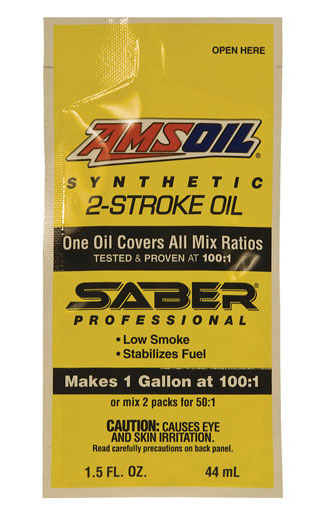There are many different kinds of 2-stroke oil on the market—so which one should you choose?]
Well, there are many benefits of using Saber Synthetic 2-Stroke Oil over other types of lubricants out there.
In fact, Saber Synthetic 2-Stroke Oil offers users fewer emissions at fuel-to-oil ratios of 80:1 and 100:1.
Also, it takes less oil to mix with a gallon of gas than some of the 2-stroke oil competitors, as you can get one gallon of 100:1 fuel out of 1.5 oz of oil.

Saber also offers superior lubrication and helps to prevent premature wear, so you can increase the lifespan of your 2-stroke motor while helping it reach peak efficiency.
Additionally, another benefits of using Saber synthetic 2-stroke oil is that…
There is no need for fuel stabilizers when using Saber Synthetic 2-Stroke Oil, so please use ethanol-free gas when mixing your 2-stroke fuel at home.
To purchase Saber Synthetic 2-Stroke Oil click here.
Or browse our online catalogue of premium AMSOIL synthetic engine lubricants today!
Saber® professional synthetic 2-stroke oil
Saber Professional Synthetic 2-Stroke Oil is a high-quality oil specifically designed for use in 2-stroke engines. It is formulated using synthetic base oils and advanced additives to provide superior lubrication, engine protection, and overall performance.
This oil is widely used in various applications such as chainsaws, trimmers, motorcycles, snowmobiles, and other equipment that relies on 2-stroke engines. It is engineered to meet the unique requirements of these engines, delivering exceptional performance under demanding conditions.
Saber Professional Synthetic 2-Stroke Oil offers several key benefits. Firstly, it is designed to minimize exhaust smoke, resulting in a cleaner and more environmentally friendly operation. Reduced smoke emissions are particularly important for applications such as chainsaws, where clear visibility is crucial.
Additionally, this oil helps to reduce carbon deposits, preventing the buildup of harmful deposits inside the engine. By keeping the internal components clean, it ensures optimal engine performance and longevity. This is especially beneficial in high-revving 2-stroke engines that tend to generate more carbon buildup.
Furthermore, Saber Professional Synthetic 2-Stroke Oil provides excellent lubrication, ensuring smooth operation and reduced friction. This helps to minimize wear and tear on engine parts, improving their durability and reliability. The oil’s advanced formulation helps to maintain proper lubrication even under extreme operating conditions, offering enhanced protection against metal-to-metal contact.
To achieve the best results, it is important to follow the manufacturer’s instructions and guidelines regarding mixing ratios and maintenance intervals. Different engines may have specific requirements, so it is crucial to consult the equipment’s manual or contact the manufacturer for accurate information.
As always, it’s important to stay updated with the latest specifications and recommendations. For the most current and detailed information about Saber Professional Synthetic 2-Stroke Oil, it is recommended to visit the product’s official website or contact the manufacturer directly.
Amsoil saber 2-stroke oil review
Amsoil Saber 2-Stroke Oil is a highly regarded product known for its exceptional performance and quality. It is specifically designed for use in 2-stroke engines and has gained a strong reputation among professionals and enthusiasts alike.
One of the standout features of Amsoil Saber 2-Stroke Oil is its advanced synthetic formulation. It is crafted using high-quality synthetic base oils and a precise blend of additives, resulting in a product that offers superior lubrication and protection for 2-stroke engines.
Users consistently praise the oil for its ability to reduce exhaust smoke. The formulation of Amsoil Saber 2-Stroke Oil is engineered to minimize smoke emissions, making it an ideal choice for applications where clear visibility is crucial. This feature is especially important in industries such as forestry and landscaping, where chainsaws and other 2-stroke-powered equipment are frequently used.
Furthermore, Amsoil Saber 2-Stroke Oil is highly effective at preventing carbon deposits. By minimizing carbon buildup within the engine, it helps maintain engine cleanliness and maximizes performance. Users often report improved throttle response and smoother operation after switching to Amsoil Saber 2-Stroke Oil.
Another notable aspect of this oil is its exceptional lubrication properties. It forms a protective barrier between moving parts, reducing friction and wear. This results in improved engine durability and longevity. Users appreciate the peace of mind knowing that their engines are well-lubricated, even under demanding conditions.
Amsoil Saber 2-Stroke Oil is known for its versatility, being suitable for a wide range of 2-stroke engines, including chainsaws, trimmers, motorcycles, snowmobiles, and more. However, it is essential to follow the manufacturer’s recommendations for the proper mixing ratios and maintenance intervals specific to each application.
Overall, based on user experiences and feedback, Amsoil Saber 2-Stroke Oil consistently receives positive reviews for its performance, engine protection, reduced smoke emissions, and overall reliability. It is a trusted choice for professionals and enthusiasts who prioritize high-quality lubrication and optimal performance in their 2-stroke engines.
Amsoil saber mix ratio
The recommended mix ratio for Amsoil Saber 2-Stroke Oil depends on the application and the specific requirements of the engine or equipment being used. It is crucial to consult the manufacturer’s guidelines or the equipment’s manual for the precise mix ratio information.
In general, Amsoil Saber 2-Stroke Oil can be used at a mix ratio of 50:1 or 100:1. The 50:1 ratio typically means mixing 2.6 ounces (76 ml) of oil with one gallon (3.8 liters) of gasoline, while the 100:1 ratio involves mixing 1.3 ounces (38 ml) of oil with one gallon of gasoline. It’s important to note that these ratios may vary depending on the specific application or manufacturer recommendations.
To ensure the optimal performance and protection of your engine, it is crucial to follow the recommended mix ratio provided by the engine manufacturer or Amsoil. This will help maintain proper lubrication and prevent potential damage to the engine caused by incorrect oil-to-gasoline ratios.
For the most accurate and up-to-date mix ratio information for Amsoil Saber 2-Stroke Oil, it is advisable to refer to the product’s official documentation, consult the manufacturer’s recommendations, or contact Amsoil directly. They will be able to provide you with the precise mix ratio for your specific engine or equipment.
Amsoil synthetic 2-stroke oil mix ratio
The recommended mix ratio for Amsoil Synthetic 2-Stroke Oil may vary depending on the specific product and the application it is being used for. It is crucial to refer to the manufacturer’s guidelines or the equipment’s manual for the accurate mix ratio information.
In general, Amsoil Synthetic 2-Stroke Oil is often mixed at a ratio of 50:1 or 100:1. The 50:1 ratio typically means mixing 2.6 ounces (76 ml) of oil with one gallon (3.8 liters) of gasoline, while the 100:1 ratio involves mixing 1.3 ounces (38 ml) of oil with one gallon of gasoline. However, it is important to note that these ratios can vary depending on the specific requirements of your engine or equipment.
To ensure optimal performance and protection of your 2-stroke engine, it is crucial to follow the recommended mix ratio provided by the engine manufacturer or Amsoil. Different engines or equipment may have specific requirements, and using an incorrect mix ratio can lead to inadequate lubrication or potential engine damage.
For the most accurate and up-to-date mix ratio information for Amsoil Synthetic 2-Stroke Oil, it is advisable to refer to the product’s official documentation, consult the manufacturer’s recommendations, or contact Amsoil directly. They will have the precise mix ratio details for your specific engine or equipment.
FAQs
Q. What are the advantages of synthetic 2-stroke oil?
A. Synthetic 2-stroke oil offers several advantages over conventional oils. Some of the key benefits include:
Improved Lubrication: Synthetic oils have a more consistent molecular structure, providing better lubrication and reduced friction, which helps protect the engine and extend its life.
Reduced Smoke: Synthetic oils are formulated to burn cleaner, resulting in reduced smoke emissions during combustion. This is particularly beneficial in applications where smoke visibility needs to be minimized, such as chainsaws or motorcycles.
Enhanced Engine Protection: Synthetic oils typically have better resistance to high temperatures, reducing the risk of engine damage due to overheating. They also provide improved protection against wear, corrosion, and carbon buildup.
Longer Service Intervals: Due to their superior performance and resistance to breakdown, synthetic 2-stroke oils often allow for extended service intervals, reducing the frequency of oil changes and maintenance requirements.
Q. Is synthetic 2-stroke oil better?
A. Synthetic 2-stroke oil is generally considered superior to conventional oils. Synthetic oils are engineered to provide consistent performance across a wide range of temperatures and operating conditions. They offer improved lubrication, better protection against wear and deposits, reduced smoke emissions, and enhanced engine cleanliness. Synthetic oils also tend to have longer service intervals, saving both time and money in the long run. However, it's important to choose a synthetic oil that is specifically designed for 2-stroke engines and follow the manufacturer's recommendations for the best results.
Q. What is the best synthetic oil for a 2-stroke engine?
A. The best synthetic oil for a 2-stroke engine can vary depending on factors such as the specific application, engine design, and manufacturer's recommendations. Several reputable brands offer high-quality synthetic oils for 2-stroke engines, including Amsoil, Red Line, Motul, and Castrol, among others. It's important to select an oil that meets the required specifications and follow the manufacturer's guidelines regarding viscosity and performance requirements for your particular engine or equipment.
Q. Does Amsoil Saber have a fuel stabilizer in it?
A. Yes, Amsoil Saber 2-Stroke Oil is formulated with a built-in fuel stabilizer. The fuel stabilizer helps prevent fuel degradation and varnish formation during storage periods, ensuring the fuel remains fresh and ready for use when needed. This feature is particularly beneficial for equipment that is frequently used seasonally or intermittently, such as snowmobiles, chainsaws, or motorcycles. The fuel stabilizer in Amsoil Saber helps maintain optimal fuel quality and engine performance, reducing the risk of fuel system issues caused by stale or degraded fuel.





